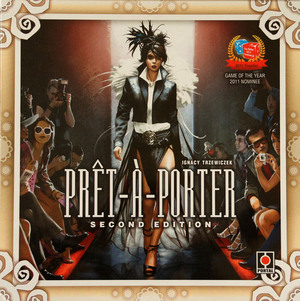And so there I was, front row center in New York's fashion district, watching as the next season of clothing strutted across the catwalk. I wiped the cheese dust from my fingers, and casually stroked my fashionable neckbeard. (From what I could tell, neckbeards appeared to be trending last season in Milan.) The auditorium dimmed and I waited, nervously. Right Said Fred's "I'm Too Sexy" began thumping from the sound system as the lights rotated into place, illuminating the thin walkway that my models were about to grace.
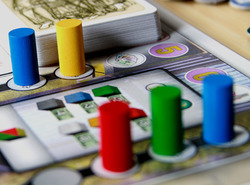 My first model set foot on the stage... and there was a collective gasp of horror from the audience. My worst fears were realized! I had spent all of my money following trends, and paid no attention to the quality focused market here. I made a gamble by trying to save money on inferior materials, but the audience definitely wasn't buying the "Burlap Chic" angle. This would be the end. I had borrowed money on empty promises and the hope that "Meeple Tees" would take the world by storm. Instead, my kneecaps had an inevitable meeting with Guido in the alleyway. It was this painful regret that would spell the end of my career as a fashionista... until the next game of Prêt-à-Porter, at least.
My first model set foot on the stage... and there was a collective gasp of horror from the audience. My worst fears were realized! I had spent all of my money following trends, and paid no attention to the quality focused market here. I made a gamble by trying to save money on inferior materials, but the audience definitely wasn't buying the "Burlap Chic" angle. This would be the end. I had borrowed money on empty promises and the hope that "Meeple Tees" would take the world by storm. Instead, my kneecaps had an inevitable meeting with Guido in the alleyway. It was this painful regret that would spell the end of my career as a fashionista... until the next game of Prêt-à-Porter, at least.
Ignacy Trzewiczek has always impressed me with his game design. I gave solid marks to his fantasy siege title "Stronghold" in my review last year, and I was very excited to see what he had been cooking up at Portal Publishing in the meantime. Luckily, his recent release, Prêt-à-Porter is now being distributed through Eagle Games in North America.
Surprisingly, this new game doesn't feature the castles, mutants, or postnuclear settings that Portal has become known for, instead opting for the ruthless world of off-the-shelf fashion. While I might have originally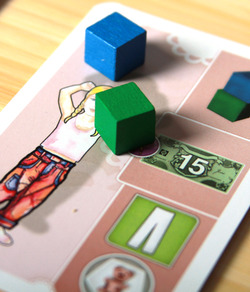 been a bit nonplussed by the fashion theme, once the confusion passed, I was happy to recognize Prêt-à-Porter for the deep, meaty, worker placement oriented business simulation that it is.
been a bit nonplussed by the fashion theme, once the confusion passed, I was happy to recognize Prêt-à-Porter for the deep, meaty, worker placement oriented business simulation that it is.
In Prêt-à-Porter, players are growing a fashion business from the ground up, and trying to find success in an ultra-competitive market. Gameplay revolves around managing money; purchasing designs and materials; as well as managing a staff of workers, real-estate, and contracts with the ultimate goal of selling Prêt-à-Porter (ready to wear clothing) through a series of fashion shows. The player who can best juggle all of these aspects of business will make the most money and emerge as the next Vera Wang of board game simulated fashion.
Components:
When I first opened the box, I was surprised by the number and variety of components. Between the myriad of colorful tokens, wooden cubes, and various cards, Portal Publishing could give Fantasy Flight a run for their money. All of the components were high quality, and fit well in the custom box insert.
Wooden Bits - Prêt-à-Porter comes supplied with a collection of colored wooden cubes to represent the different kinds of fabric that can be purchased during the game, as well as a set of action markers painted in each of the player colors. These are your typical Euro fare, but are well made, and enjoyable to handle.
Cards - Cards are used to add variety, and controlled randomness to gameplay, and fill several different roles. Cards come in two sizes: Large cards which describe patterns that the player can acquire, and smaller cards which represent employees, contracts, buildings, and other various resources found in the game. The cards are colorful, well made, and easy to manipulate.
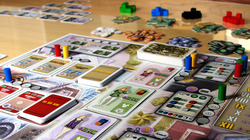 Game Board - The game is played on a quad-fold board, with various places for cards and action pawns. Where Trzewiczek's previous game "Stronghold" was vividly illustrated with a lush fantasy setting, Prêt-à-Porter is much more subdued in it's graphic design, focusing instead on icons and descriptive illustrations to facilitate smoother gameplay. While it would have been nice to see a board as beautifully illustrated as "Stronghold", the pragmatic execution of the Prêt-à-Porter board does it's job well.
Game Board - The game is played on a quad-fold board, with various places for cards and action pawns. Where Trzewiczek's previous game "Stronghold" was vividly illustrated with a lush fantasy setting, Prêt-à-Porter is much more subdued in it's graphic design, focusing instead on icons and descriptive illustrations to facilitate smoother gameplay. While it would have been nice to see a board as beautifully illustrated as "Stronghold", the pragmatic execution of the Prêt-à-Porter board does it's job well.
Player Mats - Each player's company is represented by a player mat that acts as a base of operations. The various cards and tokens that the players collect during gameplay are arranged on or around their player mat, providing an at-a-glance status of the current state of their business. The player mat also reflects the amount of money the player must pay per turn on rent, salaries, and other essentials to maintain his clothing empire.
Manual - The manual is full color, and has a pleasing design, but unfortunately suffers from some fairly severe readability issues. I found myself referring to the manual for both setup and during my first few games, and was often confronted with passages I had to read several time to understand. Much of this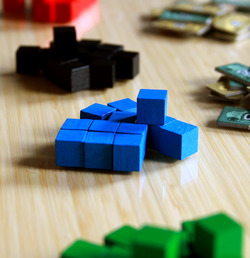 confusion comes from the translation from the original Polish. The oddly phrased sentences and broken English were sometimes ambiguous, and required concentration to extract the relevant information.
confusion comes from the translation from the original Polish. The oddly phrased sentences and broken English were sometimes ambiguous, and required concentration to extract the relevant information.
There are several player aids included that contain abbreviated rules and guidelines. These were helpful, but were difficult to use, as they were covered in paragraphs of tiny text. Much of this prose was needed to explain the various functions of cards, but the sheer amount of text made it a bit unweildly. Having more descriptive text on the cards would have been greatly appreciated, and would have avoided a lot of downtime searching through the rulebook and player aids - although the diminutive size of the cards would have made this difficult as well.
Gameplay:
In Prêt-à-Porter, players work to build clothing collections through a worker placement mechanic by collecting patterns and material while also keeping up on trends, quality, and public relations. Material is represented as painted cubes in the game, while the more abstract attributes (Trends, quality, and PR) are represented as tokens. The employee, contract, and lease cards that the players will choose during gameplay directly affect the number of these attribute tokens that the player will acquire. Since every fashion show that the player participates in will value these attributes differently, the patterns that the players collect, along with the people and places they choose invest in are critically important to keeping the financial books in the black.
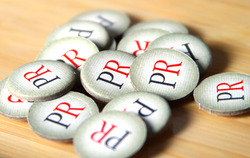 The action in Prêt-à-Porter takes place over twelve turns, with each turn representing one month of the year. Most of these turns involve buying fabrics for clothing and managing the business, however, every third month a new fashion season starts and players must sell their designs in special fashion show "scoring" rounds.
The action in Prêt-à-Porter takes place over twelve turns, with each turn representing one month of the year. Most of these turns involve buying fabrics for clothing and managing the business, however, every third month a new fashion season starts and players must sell their designs in special fashion show "scoring" rounds.
The standard (non fashion show) game turns are split into 4 distinct phases: Planning, Execution, Training/Development, and Maintenance.
Planning - In the planning phase, players take turns placing their action pawns in one of the many spaces on the board. This is where players compete for materials, clothing patterns, employees, contracts and rental space. Like most worker placement games, the number of spaces for any given action is limited, so players have to weigh the importance of any given choice, lest it be unavailable when their turn comes back around.
While some of the actions that can be taken, such as purchasing or importing materials, are fixed on the board, most other actions are defined by cards that are placed on the board at the start of each turn. This means that many of the different types of resources change from turn to turn - which adds an interesting dynamic to the game. Different cards offer different attributes, as well as game-changing abilities; so choosing where and when to invest your money is critical to success.
Execution - After all of the players have placed their action pawns, the execution phase begins. Typical of worker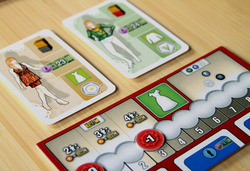 placement games, the actions are resolved in a specific order based on the numbered sections of the game board. If a player has chosen an action associated with a card, he must pay any required fees, and move the card to his player mat. Resources such as employees and leases require monthly upkeep fees which are tracked using a token on the player mat.
placement games, the actions are resolved in a specific order based on the numbered sections of the game board. If a player has chosen an action associated with a card, he must pay any required fees, and move the card to his player mat. Resources such as employees and leases require monthly upkeep fees which are tracked using a token on the player mat.
Training/Development - Most of the cards that the players acquire have two sides - a standard side and a developed side. The developed side usually gives bigger benefits, and more powerful abilities, but at a higher monthly cost. During the training and development phase, the player can choose to pay money to flip a card to it's developed side. Since developing a card is a balancing act between cost and benefit, choosing whether or not to develop a resource can make for some deviously difficult decisions.
Maintenance - This is the phase where the player handles business upkeep. Any monthly fees such as salaries and rent are paid during this phase. If a player is unable to pay these costs, he must take a high interest loan, which drastically reduces his ability to make profit.
Every three turns, a fashion show occurs. This is like a scoring round where the players score the clothing collections they have put together during the previous rounds. The fashion show is split into 5 distinct phases.
Stars Exchange - When a player has a successful showing in a fashion show he collects stars. Stars can also be collected through contracts and cards that are acquired during the standard turn. During the star 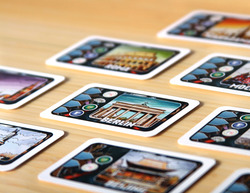 exchange phase, any stars that have been accrued are converted to "golden bills". These bills represent the value of the company, and while they cannot be spent during gameplay like normal money, they are used in determining the ultimate winner.
exchange phase, any stars that have been accrued are converted to "golden bills". These bills represent the value of the company, and while they cannot be spent during gameplay like normal money, they are used in determining the ultimate winner.
In Prêt-à-Porter, the person who ends the game with the most money is the victor. In this way, money in Prêt-à-Porter is used both as a resource and as a type of victory point. I really appreciated this, because I often feel that the abstract nature of victory points can chip away at a game's theme. While victory points take a bit of abstract thinking to digest, money is inherently understood. Even the golden bills, which cannot be used in commerce, make sense under this model and make for a very streamlined and intuitive scoring mechanism.
Collection Display - During this phase, players choose which designs they are going to present at the fashion show. Each design represents a certain type of clothing (shirt, pants, etc..), and belongs to a certain style. There is a bit of a set collection mechanism in this aspect of Prêt-à-Porter, as players can only show designs of the same style ("sports", or "vintage" for example).
Collection Comparison - This is where the players' collections are judged. As the game progresses, the players will participate in an increasing number of fashion shows during this turn. Each fashion show venue has different attributes that are judged among: Trend, Quality, PR, and Quantity. For each attribute judged at the particular venue, the players compare the number of tokens they have collected, with stars going to the player with the most. In higher player count games, the second place player will also earn a lesser number of stars.
lesser number of stars.
Collection Sale - Stars are very important to collect, but because they are converted into "golden bills" that represent the value of the brand, they cannot be used for commerce. A successful business still has to pay the bills, and this is where the Collection Sale comes in. After the collections have been judged, the player sells them for cold, hard, cash. Each clothing pattern has a sale price printed on it which the player collects during this phase. If the player has earned any stars during the fashion show, he gets bonus money for his collection.
Maintenence - Even though the fashion show rounds are scoring rounds, the players are still expected to pay their employees and rent on these turns, so like the standard phase, the player must pay his monthly fees.
Game End:
The game ends after the maintenance phase of the fashion show on the 12th game turn. The player with the most money, both standard and gold bills, wins.
Conclusion:
I enjoyed Prêt-à-Porter quite a bit. While it follows the standard worker placement recipe fairly closely, it contains interesting details that transform it into a very solid, thought-provoking game. Because it is a business simulation at heart, the game can be a bit mathy, but this calculation complements the game theme well without being too overwhelming.
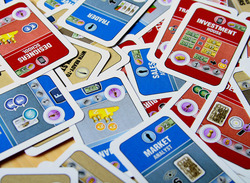 The game's theme really works with its worker placement mechanics to avoid pitfalls that other similar games succumb to. By keeping the mechanics relevant to the thematic goal, choices are intuitive, and there isn't an abstract disjoint between moving wooden bits and managing a successful clothing empire. Resources such as employees and buildings are first-come, first serve, which makes sense given the real-world nature of business. Limiting the number of players who can take an action doesn't feel like an arbitrary limitation either, as there are a finite number of resources.
The game's theme really works with its worker placement mechanics to avoid pitfalls that other similar games succumb to. By keeping the mechanics relevant to the thematic goal, choices are intuitive, and there isn't an abstract disjoint between moving wooden bits and managing a successful clothing empire. Resources such as employees and buildings are first-come, first serve, which makes sense given the real-world nature of business. Limiting the number of players who can take an action doesn't feel like an arbitrary limitation either, as there are a finite number of resources.
By interspersing scoring rounds between standard rounds, Prêt-à-Porter encourages players to think on two levels: both short term, and long term. While it may be easier to focus on the next fashion show, it's important to keep the big picture in mind by making decisions that will be beneficial later in the game. This requires a bit of speculation; because the various patterns, employees, buildings, and contracts change from turn to turn, players must take some calculated risks. A player may find himself picking up some extra material in an early round in anticipation of collecting a pattern that will use it later in the game.
In the same vein, managing loans can be a critical aspect of the game. While being forward thinking, and appropriately managing credit can be an effective strategy, shortsighted money management can force a player who has run out of money into a high-interest loan that sucks income out of his business.
The different employees, contracts, and buildings add an exciting spice to the game. Many of the abilities that these cards provide are rule-bending in nature, and can keep other players on their toes. The cards also come out in a random order every game, preventing the games from feeling static or programmed.
The theme itself may be a turn off for some. Fashion probably isn't the first thing that people think of when board games are mentioned, but I find that even though I don't have an interest in fashion specifically, the game is so successful as a business simulation, that it doesn't really matter. Replace the fashions with board games, and the fashion shows with conventions, and you could have a game that is just as compelling about board game publishing.
Knowing a bit about the history of Prêt-à-Porter makes the decision to theme it as a fashion game make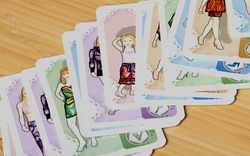 more sense. Prêt-à-Porter was actually designed as a game to learn about the economics of business, and was developed partly with a grant from the National Bank of Poland. With an educational theme, Portal could have punted on this one and developed a dry game, but the fashion theme adds a bit of excitement to gameplay that may entice would-be-gamers into the fold.
more sense. Prêt-à-Porter was actually designed as a game to learn about the economics of business, and was developed partly with a grant from the National Bank of Poland. With an educational theme, Portal could have punted on this one and developed a dry game, but the fashion theme adds a bit of excitement to gameplay that may entice would-be-gamers into the fold.
Incidentally, Ignacy Trzewiczek maintains a blog that discusses the development of his games, including Prêt-à-Porter and his experiences pitching the game to the NBP. I appreciate his storytelling almost as much as his game design, as he turns his design tales into harrowing adventures. It's definitely worth a read.
While my overall opinion of Prêt-à-Porter is overwhelmingly positive, there are a few negatives that show through. The first is the poorly translated manual. While Prêt-à-Porter is not that complicated mechanically, reading through the rulebook can certainly make it seem so. I had some issues getting through my first setup of the game, and felt a bit overwhelmed when I first read it. However, after a single play-through of the game, it began to click - and those confusing portions of the manual began to make sense. Even so, the manual may be daunting for many people.
The theme could also be a potential turn-off for some. I had a hard time pitching the game to my group due to the fashion theme. Once we started playing, and figured out the rules though, the theme was no longer an obstacle, and players were excited to play again and try different strategies.
I'm not sure the fashion theme is a negative though, more of a polarizing factor. Those gamers who may not be interested in the fantasy or post apocalyptic nature of Ignacy's other games may find that Prêt-à-Porter is an excellent introduction to his sublime designs. Prêt-à-Porter definitely isn't a light game though, and can be very cutthroat, despite its lack of direct confrontation, so keep that in mind when deciding if Prêt-à-Porter is right for your group.
Personally, I enjoyed Prêt-à-Porter quite a bit, and look forward to future plays. I emphatically recommend it to players who enjoy Euros and worker placement games. If worker placement doesn't excite you though, Prêt-à-Porter isn't going to be the title that changes your mind (for that i would suggest Ignacy's older title "Stronghold"). But with the right business savvy group, Prêt-à-Porter really delivers!
